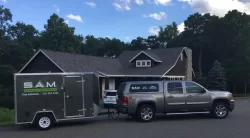
Your roof is your home’s first line of defense. It shields you from pounding rain, harsh sun, heavy winds, and in many places — ice and snow. But like anything that works 24/7, your roof needs attention.
The good news? Staying on top of small repairs and routine care can prevent expensive problems later. At Sam’s Roofing, we believe that a well-informed homeowner is a confident homeowner — so here’s your clear, no-nonsense guide to residential roof repair tips that really make a difference.
A single missing shingle might not look like much, but small issues can escalate quickly. Water damage, mold, and structural problems often start with something simple: a loose flashing, cracked sealant, or clogged gutter.
When you know what to look for — and what you can do yourself versus when to call in a pro — you’ll catch problems early and protect your family’s biggest investment.
The National Roofing Contractors Association recommends inspecting your roof every spring and fall. Use binoculars from the ground if you’re not comfortable climbing up.
Look for:
Bonus tip: After major storms, do a quick check. High winds or hail can cause damage that needs immediate attention.
Your gutters direct water away from your roof and foundation. If they’re clogged, water can back up under your shingles, causing leaks and rot.
This is one of the simplest roof repair tips that saves big headaches later.
Tree branches that hang over your roof can scrape and damage shingles, drop leaves that clog gutters, and even break off during storms.
A good rule of thumb is to keep branches at least 10 feet away from your roof when possible. If you’re trimming large limbs, it’s best to hire a professional to avoid injury or property damage.
See a water stain on your ceiling? Don’t ignore it. Even small leaks can lead to mold and structural damage over time.
If you spot a leak:
Remember: A quick patch can buy you time, but you need a permanent repair to avoid bigger problems.
Flashing — the metal strips that seal edges and joints — is a common culprit for leaks. Over time, flashing can rust, loosen, or pull away from the roof.
Check that flashing around your chimney, skylights, and roof valleys is snug and rust-free. If you see damage, repairs are best left to a pro to ensure a watertight seal.
Loose or missing shingles leave your roof deck exposed to the elements. Replacing a few shingles is relatively simple for a qualified roofer — and much cheaper than a full roof replacement down the line.
Keep a few spare shingles on hand if possible. This makes color-matching easier when you need a quick fix.
Some repairs — like cleaning gutters or trimming small branches — are safe for most homeowners. But climbing on your roof or tackling complex fixes can be dangerous.
Call a licensed roofer for:
✅ Leak repairs
✅ Flashing replacement
✅ Storm damage assessment
✅ Large shingle replacements
✅ Structural or sagging issues
Safety first — and professional work means repairs that last.
After any roof repair or maintenance, keep records of what was done and when. This is helpful for warranty claims and gives your roofer a clear history if bigger issues arise later.
If your roof is still under warranty, check whether your repairs need to be handled by a certified contractor to avoid voiding coverage.
In regions with harsh winters, ice dams are a real threat. Proper attic insulation and ventilation help prevent heat loss that causes snow to melt and refreeze at your roof’s edge.
Before winter hits:
A little prep can help your roof weather every season safely.
Your roof deserves more than a quick fix from a door-to-door storm chaser. A local, reputable roofing contractor understands regional weather challenges, building codes, and the materials that hold up best.
At Sam’s Roofing, we’re proud to help homeowners make smart choices that protect their roofs, extend their lifespan, and provide peace of mind — rain or shine.
Want more information on maintaining and repairing your roof safely? The National Roofing Contractors Association is a helpful, non-profit resource for homeowners looking to understand roof systems, maintenance, and industry standards.
Your home deserves a sturdy, well-maintained roof — and that starts with a little knowledge and the right partner by your side. Take these roof repair tips to heart, and you’ll help your roof stand strong for years to come.
For honest advice or help tackling your next roofing project, contact us anytime!

